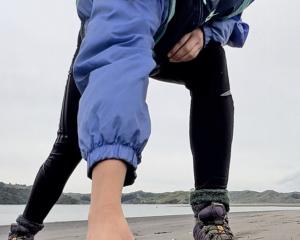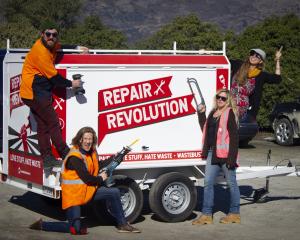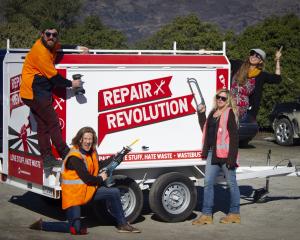
Why do half the clothes in my wardrobe never get worn? How many clothes is enough? How can I choose sustainable fashion?
If you’ve ever asked yourself any of these questions, March could be your month for answers. Wastebusters is inviting everyone to join us in the Six Items Challenge, changing the way we choose our clothing for the month of March. The challenge is to limit your wardrobe for the month to six main items (excluding underwear, footwear, active wear, accessories and a jacket).
I won’t kid you, it’s not easy! For some, like mothers of banana-loving preschoolers, it was proven during last year’s challenge that it’s pretty much impossible — which is why this year we’ve introduced a couple of more accessible options: the Wildcard Six and the Flex-Six. Whichever Six Items Challenge you choose, committing to wearing the same items of clothing for a month is a break from our normal clothing (and shopping) habits, giving us a chance to think about what sustainable fashion looks like for us.
The Six Items Challenge was launched in England by Labour Behind the Label to challenge exploitation of workers and the environment. Fashion waste is one of those dirty little (or in this case massive) secrets it’s easy to look away from. Most people never see the piles of discarded clothes that are thrown away each day. We rarely think about where all the new clothes displayed in shops each season are going to end up.

A report on circularity in the clothing and textile industry in Aotearoa, released by Usedfully in November 2020, found that we can’t keep shutting our eyes to the true costs of fast fashion. ‘‘The model depends on taking more and more resources, processing them into products, selling them to consumers and then encouraging them to buy more. The unintended environmental and social consequences of this model have become too big to ignore.’’
Part of that is about all the clothing that ends up in the landfill, where greenhouse gases are released as textiles decompose. Textiles are a hot spot for emissions in landfill, the Usedfully report says, estimating that 220,800 tonnes of textiles end up there in Aotearoa each year — including clothes, but also the likes of carpet — generating 397,440 tonnes of CO2e.
The Six Items Challenge is one way to fight back against fashion waste. My favourite thing about the challenge could well be the pre-challenge SOS meeting. It involves a desperate cry for help, a bottle of red wine, and a friend who always looks fabulous and is happy to give some non-judgemental feedback. It ends with six items to wear for March and a pile of things to give back to Wastebusters.
I discovered last year that my wardrobe is full of random things, all of which appeal to me because of the colour or fabric but none of which really go together. Many of them are completely impractical to bike in, which I do nearly every day, or for work in our unconventional office space at Wastebusters. I refuse to dry-clean any items of clothing, meaning they were so wrinkled after washing that they don’t look great or even fit properly (clothes seem to get bigger when they’re ironed — who knew?). It made me realise that holding on to clothes when I wasn’t wearing them or even looking after them properly, was a wasteful habit.
Consequently, my six items choice was limited to practical items that didn’t clash: grey shorts, black trousers, a neutral T-shirt — it was as boring as it sounds. By the end of March, I couldn’t wait to dress up. No longer was I throwing on a pair of jeans and a T-shirt when I jumped out of bed, I was wearing dresses and even shoes that weren’t trainers! It gave me a new respect for those clothes that make you feel more like yourself, the ones that make you feel good when you walk out the door. I wanted to wear them more often, I wanted to look after them, I wanted to iron!
Admittedly, it took me the rest of the year to actually buy the iron, but by last month, I was all ready to go for this year’s challenge. In an even bigger panic this year because my black pants had been relegated to the gardening drawer, I put out the SOS call and went shopping for red wine. The result? Surprisingly, an improvement on last year because some items could actually be worn together. Yesssss, my second-hand shopping is improving.
The combination of the thumbs up, the wine and the iron must have gone to my head, because my six items have gone more dressy than intended. I’m stuck for a whole month without a pair of jeans. Or even a T-shirt. It’s only the first week, and I’m not sure I can keep this up for a month! Still, at least the clothes are being worn instead of being wasted in my wardrobe.
Friends are taking all sorts of approaches to their Six Items Challenges: from bold and colourful, to capsule wardrobes to just winging it. There’s no wrong way to approach the Six Items Challenge, and no one lesson to learn. It’s really just a starting point for conversation and questions about how we can make fashion work for us and the planet.
If there’s anything I’ve learnt during 13 years at Wastebusters, it’s that waste problems are complex and require collaborative solutions. Change doesn’t happen without a commitment across all levels: individuals, businesses, local and central government.
There’s already some excellent work happening within the fashion industry to make fashion more circular and sustainable, with organisations such as the Formary and Mindful Fashion leading the way. The Government is also making progress to reduce waste in general by raising the waste levy, bringing in some mandatory product stewardship schemes (although not for textiles, yet!) and working on a new waste strategy for New Zealand.
As individuals, we can help drive the change too. If you’re thinking of giving the Six Items Challenge a go, I recommend connecting with others to share your highs and lows. You could convince a couple of friends, or connect an online community through the Wastebusters Facebook event and Instagram page.
Sign up for the challenge at the Wastebusters website. We can also send you stories and information about the challenges of (and solutions to) fashion waste. The idea is not to be perfect, but just to give it a go.
Looking critically at our clothing helps us to decide what to keep and what to pass on to others, because the first step in reducing fashion waste is to stop buying new clothes and wear what already exists.
The Six Items Challenge
Choose your challenge
The Straight Six
Limit your wardrobe for the month of March to six main items. Excludes underwear, footwear, active wear, PJs, accessories and a jacket.
The Wildcard Six
The Straight Six (excludes underwear, footwear, active wear, PJs, accessories and a jacket) plus the addition of one wildcard choice per week
The Flexi-Six
Choose the number of items to suit your lifestyle — it could be 8, 10 or 12 (excludes underwear, footwear, active wear, PJs, accessories and a jacket)
- Financial support for the Six Items project has been provided by the Waste Minimisation Fund, administered by the Ministry for the Environment, and from Queenstown Lakes District Council’s Waste Minimisation Plan.












